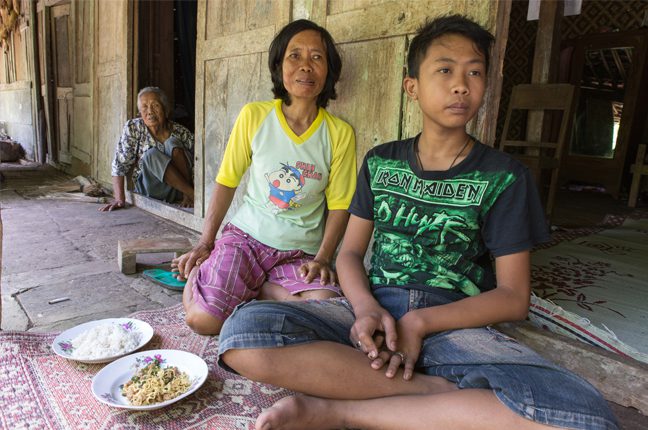
HELP SAVE LIVES
Right now Oxfam is responding to emergencies around the world, including the recent earthquake and tsunami in Indonesia.
How the “less prosperous” farmers live
By Juan Martorana – blogging from Indonesia
In a country of 240 million people, in which 110 million are of working age, and 40 million work within the agricultural sector, about 70% of this last figure is landless labourers. A lot of people! And it is one of these, Ibu Samiyah, a “less prosperous” farmer as she and millions of others have been colloquially and euphemistically described, that I met soon after the harvest of Ibu Par’s rice.
Ibu Samiyah is 45 years old. Her husband left her and she is now the sole bread-winner in a household of five that includes her 12-year-old son, Reno, her two elderly parents and her sick brother. She is landless day-labourer living with four others in her parent’s home. On the day I met Ibu Samiyah, she described matter-of-factly how she had worked yesterday, but had “not been invited to work” today.
Crouched to speak under the very-low verandah of her house, I spoke to Samiyah about her working life and the implications for her and her family’s food security. “I make money as a labourer [on other people’s land]. I have only 25,000 rupiah [around $AUD 2.50] in savings which is for my son’s schooling,” she says.
Although harvest times — like now — are the busiest time of the year, and the time when Samiyah gets most of her work, the reality is that this equates to just two to three days of work each week. In the lean times, she may not get work for a month she tells me. “Sometimes I get paid 20,000 rupiah [for a day’s work – around $AUD 2.00].” For yesterday’s work Ibu Samiyah received a bag of rice. “This is rice from yesterday”, she says pointing to the small bowl in front of her.
“[This is] for me and my son.” Beside this is another small bowl of noodles – the rice is plain, and little vegetables with the noodles. “I eat this about 12 [noon],” she says. “This is it for today. If we [my son and I] don’t finish the rice, we will have some later.” There is a similar portion to be shared by Samiyah’s parents.
They will have this one meager meal today. The only other food in this house is around 20 cobs of corn hanging from an outside wall a few metres away. They are black, perhaps from soot, and appear to have been there a long time.
When asked what type of support would be most useful for her and her family, Samiyah replied, “The land! If I had the land I could…feed myself and my family.”
Later in the day I stumble upon Ibu Samiyah being paid to work for Ibu Par; helping her bag the rice Ibu Par harvested the day before. While this is a typical response from neighbours to those in need within their local community, at just AUD $7.50 per square metre, one wonders why more cannot be done by the Indonesian government or international community to support women like Ibu Samiyah to get access to land. Particularly given that women are now increasingly being recognised by men as integral to the success of farming in Wareng; and I suspect many other places in Indonesia too.